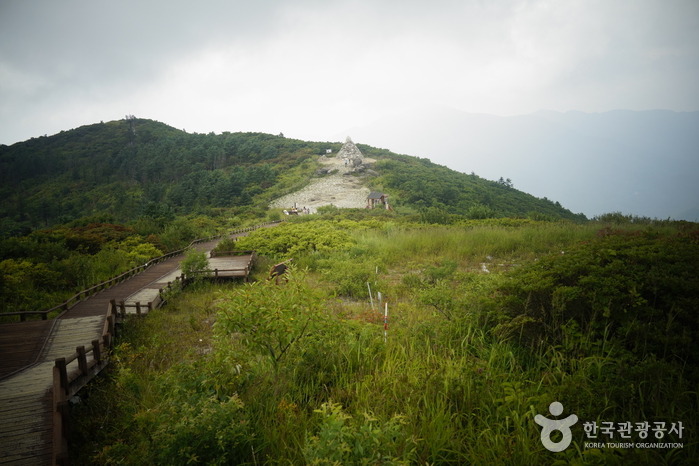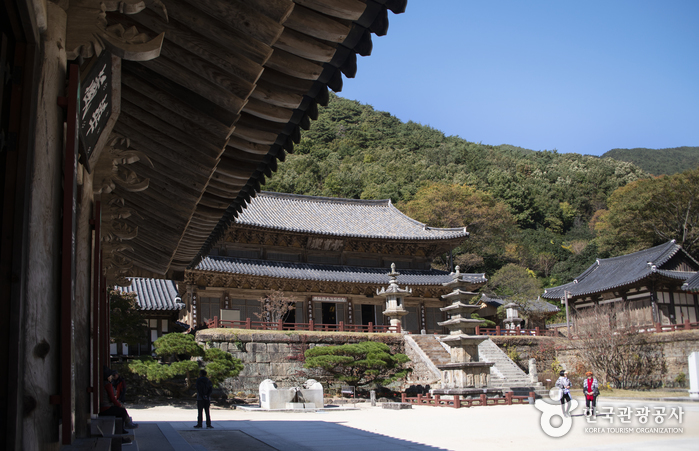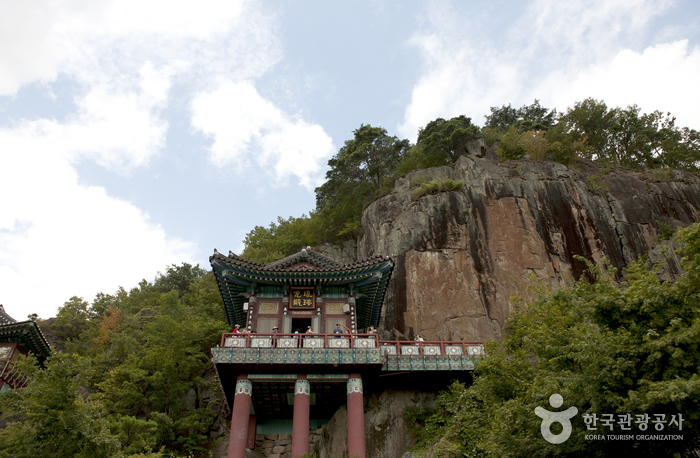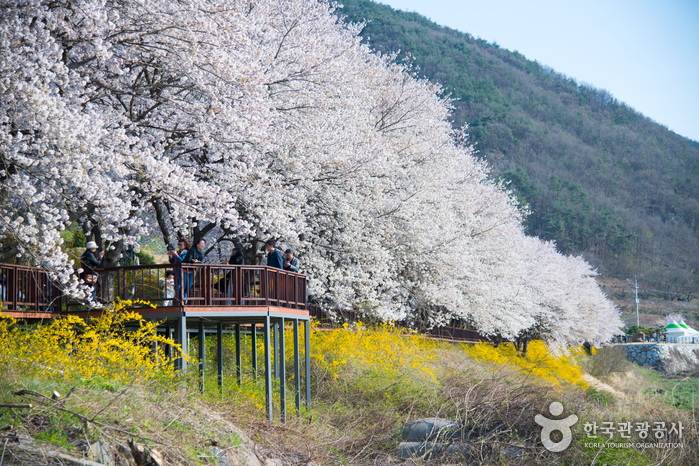Jirisan National Park (Nogodan Peak Section) (지리산국립공원 (지리산 노고단))
0m 41717 2021-12-25
356, Hwaeomsa-ro, Gurye-gun, Jeollanam-do
+82-61-780-7700
Jirisan National Park covers a vast amount of land in three provinces, including one city and three counties. The countless mountain peaks both large and small blend harmoniously, giving off a comforting ambiance. The valleys feature streams, waterfalls, and more natural attractions beautiful all year round. The mountain is the starting point for the Seomjingang River, which flows into the southern sea.
The park is home to many plants and animals, including the Asiatic black bear. There are many hiking paths crossing the park; it is recommended to make a plan for the courses in advance, checking the lengths and time required. As Jirisan Mountain changes with the different seasons, hikers can enjoy various aspects of the mountain’s terrain. However, some areas will be closed off for hikers' safety in the case of incliment weather or to prevent forest fires in the dry season.
Hotel Jirisan Haetsal [Korea Quality] / 지리산햇살 [한국관광 품질인증/Korea Quality]
281.01722616919255m 61 2021-03-27
386-3, Hwaeomsa-ro, Gurye-gun, Jeollanam-do
+82-61-783-9600
This hotel is located about 300 m away from Jirisan National Park’s Nambu Visitor Center. Built with red bricks and having an orange roof and grass lawn, the hotel resembles a country home. The hotel is surrounded by Jirisan Mountain to the back, and the Masancheon Stream, a branch of Seomjingang River, flowing through the area offers a great view for the visitors. There are five types of rooms, accommodating 2, 4, and 6 guests. A cleaning service is offered every day. The rooms have white walls and wood floorboards, tastefully furnished in a minimalist style. The wide windows offer a great view of the lawn and the mountains. All rooms other than the 4-person ondol (under-the-floor heating system) room are bedrooms, and the 6-person Special Room comes with a wooden terrace. Visitors can enjoy grilling by the valley. The hotel is located about 10 min by car from Gurye Public Bus Terminal. Hwaeomsa Temple, a temple with a thousand-year history, is located only 2 km away from the hotel, while a 10-min drive brings one to Gurye Fifth-day Market and “Unjoru House, Gurye,” which is the Folk Cultural Heritage No. 8 of Korea.
Hwaeomsa Temple (화엄사)
1.8 Km 40035 2021-02-05
539, Hwaeomsa-ro, Gurye-gun, Jeollanam-do
+82-61-783-7600
Situated at the foot of Jirisan Mountain, 5.4 kilometers east of Gurye-eup, Hwaeomsa Temple was constructed in the 22nd year of King Seong's reign (544) during the Baekje era, but was burnt down during the Imjin War (1592-1598). The temple was rebuilt in 1636 after seven years of reconstruction. The temple has various cultural assets including National Treasures, Treasures, a Natural Monument, and local cultural assets as well as 20 different buildings.
Gurye Special Tourist Zone (구례 관광특구)
2.0 Km 24065 2020-03-18
539, Hwaeomsa-ro, Gurye-gun, Jeollanam-do
+82-61-780-2450
The vast region of the Gurye Special Tourist Zone comprises Toji-myeon, Gwangui-myeon and Sandong-myeon, which has a river and an open field surrounding the mountainous area. Every part of Gurye deserves the title of Special Tourist Zone for offering many things to see. Well-known for its rich soil, the most outstanding natural resources of Gurye is Jirisan National Park, the first to be designated as a national park, and Seomjingang River.
Every year, many hikers visit Jirisan National Park, also called the “bosom of a mother.” The park is cherished for its unpolluted scenery, such as its deep and wide geographical features and crystal clear valleys. The park offers diverse hiking trails and has mountain retreats for backpackers.
Jirisan Dulegil Trail that runs along the periphery of Jirisan Mountain is where one could enjoy the experience of mountain glens, different from mountaineering. On their way hikers and trekkers can see groups of Sansuyu (cornus fruit) in spring as well as the autumnal tints of the mountain and valley in autumn.
Another strength is that the park has different types of accommodations including Hanok (Korean traditional house) homestay and a guest house, apart from leisure facilities including hot springs in Jirisan. The park is a great place for historical inquiries as it is filled with historic temples, including Hwaeomsa Temple and Yeongoksa Temple, and historic relics. Flowing from Gokseong to Hadong, Seomjingang River creates a tranquil ambience. The cleanest ever in Korea, a large number of marsh snails and sweetfish live in this river. Visitors can also enjoy the scenic view from the riverside road and various festivals which are held all year round, such as the Sansuyu Festival, the Seomjingang Riverside Cherry Flower Festival and the Piagol Autumn Foliage Festival.
* Current State of Gurye Special Tourist Zone
1) Districts Covered / Areas around Toji, Masan, Gwangui and Sandong-myeon, Gurye-gun, Jeollanam-do
2) Area / 78,024,000㎡
* Tourist Attractions
Jirisan Mountain, Seomjingang River, Jirisan Spa Land, Piagol Valley, Sansuyu Theme Park, Hwaeomsa, Cheoneunsa and Yeongoksa Temple, Hanok Village, etc.
Yeoneu [Korea Quality]여느[한국관광 품질인증]
2.2 Km 1 2023-05-23
116-68 , Cheonbyeon-gil, Gurye-gun, Jeollanam-do
+82-10-7353-1802
Pension Yeoneu in Gurye, Jeollanam-do, stands on the site where Korean independence activist Wang Jae-il was born. The mint-green roof gives the place a fairy tale feel, while inside it’s friendly and welcoming. The pension is let out as a single house, which includes an annex building with a large bathtub, a sunroom, and a sun deck. Throughout the house, guests will notice vintage items collected from the owner’s travels in the US, Europe and Korea.
Gurye Cheoneunsa Temple (천은사(구례))
3.7 Km 14499 2021-10-02
209, Nogodan-ro, Gurye-gun, Jeollanam-do
+82-61-781-4800
Located north of Gurye on Jirisan Mountain, and built during the Unified Silla Period, Cheoneunsa Temple is one of the three great Buddhist temples of Jirisan Mountain. Cheoneunsa Temple is believed to have been built by Monk Deokun and Monk Seru from India in AD 828 during the 3rd year of King Heungdeok. Because it initially laid next to spring water as clean and cold as a morning dew, the temple was also called Gamrosa, meaning Sweet Dew Temple. The spring water was rumored to clean one’s body and soul, leading to crowd of Buddhist monks to visit the temple. During King Chungryeol’s reign, the temple was named the Best Temple in the south.
The temple was burned down during the Imjin War (1592-1598) and then later rebuilt and renamed Cheoneunsa. Legend has it that while the temple was being rebuilt, a large serpent often came out of the spring. When the serpent was finally captured and killed, the spring waters suddenly dried up. Hence the name Cheoneunsa, meaning Disappearance of Spring Water, was given.
Gurye Fifth-Day Market & Gurye Traditional Market (구례5일장 / 구례전통시장(3, 8일))
3.8 Km 16129 2021-01-13
20, 5ilsijangjageun-gil, Gurye-gun, Jeollanam-do
+82-61-780-2358
Gurye is famous for its location near the first national park, Jirisan Mountain, and is home to clean water and spacious fields near Seomjingang River. The main products of this area include a variety of wild herbs, vegetables, sansuyu (cornus fruit) and plums from Jirisan Mountain and Baegunsan Mountain.
Houses with cornus fruit trees are easily found in the district of Sandong-myeon, Gurye-gun and the whole village gets dyed yellow in the spring and red in the fall. The amount of sansuyu from the area accounts for nearly half Korea’s total.
Also, chestnuts are common in Gurye Market as a complex of chestnut tree takes up 1,400 ㏊ of the land.
Saseongam Hermitage (Gurye) (사성암(구례))
6.8 Km 37101 2024-02-19
303 Saseongam-gil, Muncheok-myeon, Gurye-gun, Jeollanam-do
Saseongam Hermitage is a hermitage located at the peak of Osan in Gurye (elevation 531m). It is estimated to have been built during the Baekje period (B.C. 18-A.D. 660). Many people visit it to see the sanctuary where the 53 statues of the Buddhist Avatamsaka Sutra are enshrined. The view of the Seomjingang River and the village from the temple is magnificent, and the refreshing breeze feels as if it penetrates through one's body, leading to its designation as a scenic spot in August 2014.
Gurye Seomjingang Cherry Blossom Trail (구례 섬진강 벚꽃길)
7.1 Km 1 2022-10-25
Muncheok-myeon, Gurye-gun, Jeollanam-do
+82-61-780-2227
The Seomjingang Cherry Blossom Trail in Gurye follows National Roads 17 and 19 along the pristine Seomgjingang River. Stretching over 3 kilometers, the trail is lined with cherry blossom trees planted in 1992. As well as being a popular drive course, the trail can also be enjoyed on foot, and is even used as a marathon course. The trail has received recognition as one of the "100 Most Beautiful Roads in Korea." Restaurants along the trail serve local foods such as euneo hoe (sliced raw sweetfish) and minmul maeuntang (spicy freshwater fish stew).
Piagolgyegok Valley (피아골계곡)
7.2 Km 16089 2024-02-02
Piagol-ro, Gurye-gun, Jeollanam-do
+82-61-780-7700
Piagolgyegok Valley is located in Jirisan Mountain between Nogodan and Banyabong Peaks. The name of the valley comes from the crimson red maple leaves that fill the valley in fall. It is also one of the ten most beautiful highlights of Jirisan Mountain. The valley is famous for its fall colors, but it is also a beautiful place to visit all year around, from azaleas in spring to snow-covered rocks in winter.
Near the entrance to Piagolgyegok Valley is the largest temple in Jirisan Mountain, Yeongoksa Temple, and national treasures. The valley is not steep, providing an easy walk for all visitors. The trail stretches 6 kilometers from the ticket booth, and passes many beautiful places like Yeonjudam and Samhongso Pond. At the end of the valley, the trail continues another 2 kilometers up a steep hillside to reach Imgeollyeong Pass.

![Hotel Jirisan Haetsal [Korea Quality] / 지리산햇살 [한국관광 품질인증/Korea Quality]](http://tong.visitkorea.or.kr/cms/resource/03/2708603_image2_1.jpg)


![Yeoneu [Korea Quality]여느[한국관광 품질인증]](http://tong.visitkorea.or.kr/cms/resource/34/2949134_image2_1.jpg)


 English
English
 한국어
한국어 日本語
日本語 中文(简体)
中文(简体) Deutsch
Deutsch Français
Français Español
Español Русский
Русский